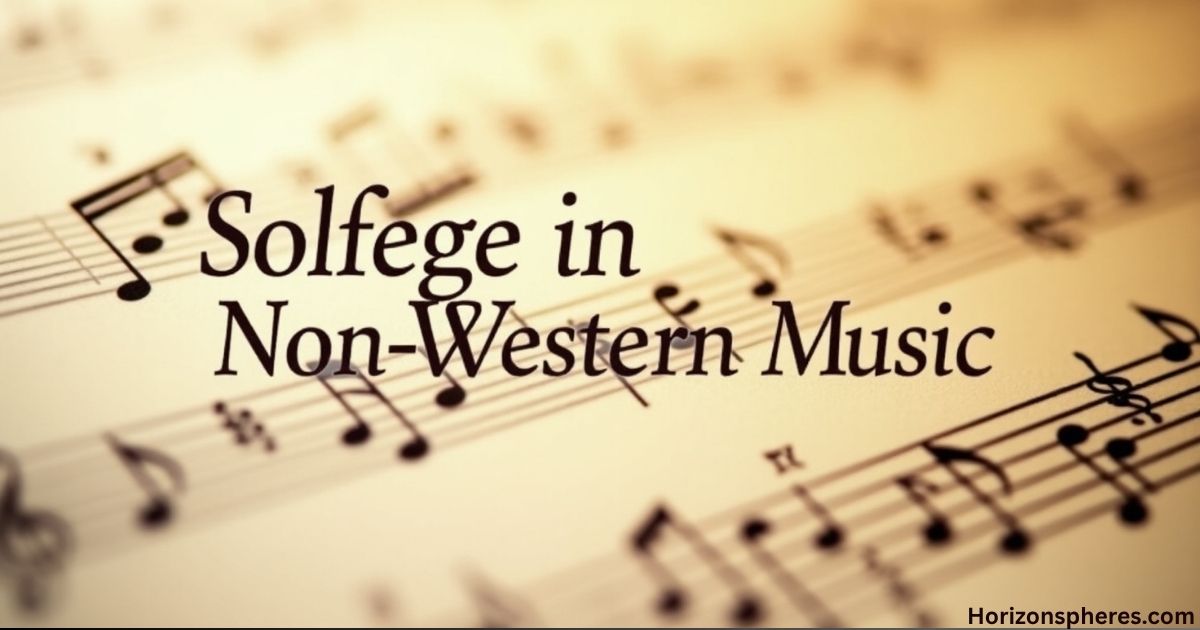You’ve hummed it countless times. Do-Re-Mi-Fa-Sol-La-Ti-Do. That familiar melody from The Sound of Music isn’t just entertainment—it’s your introduction to solfege, one of music’s most powerful learning tools.
Solfege transforms abstract musical concepts into something tangible and memorable. This isn’t just about memorizing syllables. Solfege meaning goes deeper—it’s about developing musical intuition, improving your ear, and unlocking the universal language of music.
What is Solfege?

Solfege (pronounced “soul-FEZH”) represents a revolutionary approach to musical education. This system assigns specific syllables to each note of the musical scale, creating a universal language for pitch identification and musical communication.
The complete solfege notes sequence follows this pattern: Do-Re-Mi-Fa-Sol-La-Ti-Do. Each syllable corresponds to a specific scale degree, with Do serving as the foundational “home” note. When you reach Ti, the sequence returns to Do an octave higher, creating a cyclical pattern that mirrors how musical scales function.
Core Elements of Solfege
| Syllable | Scale Degree | Musical Function |
| Do | 1st | Tonic/Home base |
| Re | 2nd | Supertonic |
| Mi | 3rd | Mediant |
| Fa | 4th | Subdominant |
| Sol | 5th | Dominant |
| La | 6th | Submediant |
| Ti | 7th | Leading tone |
Solfege meaning in English translates to “musical syllable naming system.” It’s more than notation—it’s a complete framework for understanding how pitches relate to each other within musical contexts.
Origin of Solfege
The solfege origin traces back to 11th-century Italy, where Guido of Arezzo, a Benedictine monk and music theorist, revolutionized musical education. Frustrated by his students’ difficulty memorizing Gregorian chants, Guido developed an ingenious solution.
He drew inspiration from the Latin hymn “Ut queant laxis,” extracting the first syllables of each line: Ut-Re-Mi-Fa-Sol-La. These syllables naturally ascended in pitch, creating a memorable pattern that students could easily internalize.
Historical Evolution
- 11th Century: Guido of Arezzo creates original six-syllable system
- 16th Century: “Ti” (originally “Si”) added to complete seven-note scale
- 17th Century: “Ut” gradually replaced by “Do” for easier pronunciation
- 19th Century: System spreads throughout European music education
- 20th Century: Becomes standard in American music curricula
Guido’s innovation solved a critical problem: how to teach pitch relationships without relying solely on written notation. His system enabled musicians to “think in pitch” rather than just read symbols.
Types of Solfege Systems
Two distinct approaches dominate solfege education worldwide, each serving different musical goals and cultural preferences. Understanding these systems helps you choose the right approach for your musical development.
Fixed Do and Movable Do represent fundamentally different philosophies about how we perceive and organize musical pitches. Your choice between them affects everything from sight-reading to improvisation abilities.
1. Fixed Do System
Fixed Do assigns each syllable to a specific pitch regardless of key signature. Do always equals C, Re always equals D, and so forth. This system dominates classical music education in France, Italy, and Spain.
| Syllable | Fixed Pitch | Enharmonic Equivalents |
| Do | C | B♯ |
| Re | D | C𝄪, E♭♭ |
| Mi | E | D𝄪, F♭ |
| Fa | F | E♯, G♭♭ |
| Sol | G | F𝄪, A♭♭ |
| La | A | G𝄪, B♭♭ |
| Ti | B | A𝄪, C♭ |
Fixed Do excels in classical repertoire where absolute pitch recognition matters. Musicians trained in this system can instantly identify written pitches and maintain consistent intonation across different keys.
More Post: SMH Meaning: Professional Alternatives 2025 to “Shaking My Head” That Won’t Ruin Your Reputation
2. Movable Do System
Movable Do adapts syllables to any key, with Do representing the tonic (first scale degree) regardless of actual pitch. This system dominates American music education and proves superior for ear training development.
In C Major: Do=C, Re=D, Mi=E In G Major: Do=G, Re=A, Mi=B In F Major: Do=F, Re=G, Mi=A
Movable Do teaches relative pitch relationships, making transposition intuitive and improvisation more accessible. Students learn to hear function rather than absolute pitch, developing stronger musical instincts.
Why Is Solfege Important in Music?
Solfege transforms musical learning from mechanical memorization into intuitive understanding. This system develops multiple cognitive and musical skills simultaneously, creating well-rounded musicians who think as clearly as they perform.
Research consistently demonstrates solfege’s effectiveness in developing pitch accuracy, sight-reading fluency, and musical memory. Students who master solfege demonstrate superior interval recognition and harmonic understanding compared to those using alternative methods.
Key Benefits of Solfege Training
- Enhanced Pitch Accuracy: Develops precise intonation through syllable association
- Improved Sight-Reading: Creates instant recognition of melodic patterns
- Stronger Musical Memory: Syllables provide memorable hooks for complex passages
- Better Ear Training: Builds ability to identify intervals and chord progressions
- Easier Transposition: Enables quick key changes using familiar syllable patterns
- Deeper Music Theory: Connects abstract concepts to practical application
Professional musicians across genres credit solfege with developing their musical intuition. Jazz improvisers use it for complex chord substitutions, while classical singers rely on it for accurate sight-reading in multiple languages.
Common Use Cases of Solfege in Everyday Learning
Solfege appears throughout American musical culture, often in ways you might not recognize. From elementary classrooms to professional recording studios, these syllables serve as universal musical communication tools.
Children’s music education relies heavily on solfege because young minds absorb syllable patterns more easily than abstract pitch concepts. Teachers use Do-Re-Mi games, songs, and activities to build fundamental musical skills before introducing complex notation.
Adult learners discover solfege through community choirs, where directors use syllables to teach parts efficiently. Many find that Do-Re-Mi patterns help them navigate complex harmonies they couldn’t read traditionally.
Understanding the Meaning Behind Each Syllable
Each solfege syllable carries unique emotional and functional characteristics that guide musical expression. These aren’t arbitrary labels—they represent specific relationships within the musical scale that affect how we perceive and perform melodies.
Do serves as the gravitational center, the “home” that provides stability and resolution. Ti creates tension, always wanting to resolve upward to Do. Understanding these relationships transforms mechanical singing into expressive musicianship.
Syllable Characteristics
- Do: Stable, strong, resolved—the musical “home base”
- Re: Questioning, slightly unstable, moving upward
- Mi: Stable, part of major triad, bright and cheerful
- Fa: Tense, pulls toward Sol, creates harmonic movement
- Sol: Open, powerful, often climactic in melodies
- La: Smooth, emotional, softer than Sol
- Ti: Highly unstable, leading tone, demands resolution to Do
Solfege hand signs reinforce these characteristics through physical gesture. Do uses a closed fist (stability), while Ti points upward (leading to resolution). This kinesthetic approach helps students internalize syllable functions.
Solfege in Non-Western Music

Global music traditions developed similar systems independently, suggesting universal human need for pitch organization. These parallel developments validate solfege’s effectiveness while offering insights into different cultural approaches to musical education.
Indian classical music uses Sargam (Sa-Re-Ga-Ma-Pa-Dha-Ni), which closely parallels Western solfege. Chinese music employs numerical notation (1-7), while Arabic traditions have regional variations serving identical functions.
International Comparison
| Culture | System | Syllables/Numbers |
| Western | Solfege | Do-Re-Mi-Fa-Sol-La-Ti |
| Indian | Sargam | Sa-Re-Ga-Ma-Pa-Dha-Ni |
| Chinese | Jianpu | 1-2-3-4-5-6-7 |
| Arabic | Solmization | Various regional systems |
Cross-cultural musicians often master multiple systems, finding that each offers unique insights into musical structure. Solfege meaning in Hindi would translate to “sur-sadhana” (pitch practice), reflecting similar educational goals across cultures.
Is Solfege Only for Singers?
Instrumentalists benefit enormously from solfege training, though many don’t realize its applications beyond vocal music. Pianists use syllables to internalize scale patterns, while string players rely on solfege for precise intonation without frets.
Jazz musicians particularly value solfege for improvisation, using syllables to navigate complex chord changes intuitively. Classical instrumentalists employ solfege for sight-reading orchestral parts and understanding harmonic progressions within ensemble contexts.
Instrumental Applications
- Piano: Scale pattern internalization, chord recognition
- Violin/Viola: Intonation development, fingerboard navigation
- Guitar: Fretboard understanding, improvisation framework
- Winds: Pitch accuracy, ensemble intonation
- Brass: Harmonic series understanding, accurate pitch production
Professional orchestras sometimes use solfege during rehearsals to clarify pitch relationships or fix intonation problems. The syllables provide common language for discussing musical issues across different instruments.
More Post: ❄️ Snowball Kiss Meaning Explained: The Hidden Truth Behind This Viral Slang Term
How Solfege Connects to Music Theory
Solfege serves as the bridge between abstract music theory concepts and practical musical application. Rather than memorizing rules, students experience harmonic functions through syllable relationships, making complex theory intuitive and memorable.
Interval training becomes natural when using solfege. Do to Mi always sounds like a major third, regardless of key. This consistency helps students recognize intervals by ear and understand their harmonic implications.
11 Practical Examples of Solfege in Action
Real-world solfege applications demonstrate the system’s versatility across musical contexts. These examples show how syllables function in everything from basic exercises to professional performance situations.
Classroom teachers use these patterns daily, while professional musicians employ them for efficient rehearsal and performance preparation. Each example builds specific skills while reinforcing overall musical understanding.
Practice Applications
- Scale Warm-ups: Do-Re-Mi-Fa-Sol-La-Ti-Do ascending and descending
- Phrase Endings: Mi-Re-Do creates satisfying melodic closure
- Folk Songs: “Twinkle, Twinkle” as Do-Do-Sol-Sol-La-La-Sol
- Interval Drills: Do-Mi (major third), Do-Sol (perfect fifth)
- Key Changes: Shifting Do from C to G for modulation practice
- Kinesthetic Learning: Solfege hand signs coordination with singing
- Harmony Parts: Choir sections using syllables instead of words
- Ear Training: Identifying played notes through solfege syllables
- Jazz Improvisation: Creating solos over chord changes using syllables
- Song Analysis: Mapping familiar melodies to solfege patterns
- Vocal Agility: Do-Mi-Do-Re-Fa-Re-Mi-Sol-Mi flexibility exercises
Solfege vs. Letter Notes: What’s the Difference?
Two naming systems coexist in music education, each serving distinct purposes. Letter notes (A-B-C-D-E-F-G) identify absolute pitches, while solfege emphasizes functional relationships within musical contexts.
American students typically learn both systems, using letters for instrumental music and solfege for vocal training. Understanding when to emphasize each system optimizes learning outcomes for different musical goals.
Professional musicians master both systems, switching between them as musical situations require. Solfege chart displays help students visualize relationships between both naming conventions.
Choosing Between Movable Do and Fixed Do
Your musical goals should determine which solfege system you prioritize. Movable Do excels for ear training and improvisation, while Fixed Do serves classical repertoire and absolute pitch development.
American music educators generally favor Movable Do for beginning students, transitioning to Fixed Do for advanced classical training. This progression builds relative pitch skills before tackling absolute pitch challenges.
Decision Factors
Choose Movable Do for:
- Relative pitch development
- Jazz and popular music focus
- Transposition skills
- Ear training emphasis
- Beginning music education
Choose Fixed Do for:
- Classical music specialization
- Absolute pitch training
- European conservatory preparation
- Professional orchestral work
- Advanced sight-reading requirements
Hybrid approaches combine both systems, giving students maximum flexibility. Many American conservatories teach both methods, allowing students to choose based on their specialization and career goals.
More Post: ICL Meaning EXPOSED: The Secret Texting Code That’s Revolutionizing Digital Communication in 2025
Cultural Significance of Solfege
The Sound of Music single-handedly introduced solfege to mainstream American culture. Julie Andrews teaching the Von Trapp children created instant recognition for Do-Re-Mi, making these syllables part of popular consciousness.
Modern media continues referencing solfege, from animated movies to social media challenges. TikTok users create viral content using solfege patterns, while YouTube educators build channels around Do-Re-Mi concepts.
Pop Culture Impact
- Broadway musicals incorporate solfege for quick melody teaching
- Television shows reference Do-Re-Mi for comedic or educational effect
- Educational apps use Sound of Music imagery for marketing
- Social media challenges featuring solfege singing
- Movie soundtracks include solfege-based teaching scenes
International recognition of American solfege popularization has influenced global music education. Many countries now include “Do-Re-Mi” in their curricula specifically because of its cultural familiarity.
Solfege in Education Systems Worldwide
Global implementation of solfege varies dramatically based on cultural traditions and educational philosophies. European conservatories maintain classical approaches, while American schools emphasize practical application and accessibility.
Asian music programs increasingly incorporate Western solfege alongside traditional systems. This fusion creates musicians comfortable with multiple cultural approaches to pitch organization and musical thinking.
International Approaches
| Region | System Preference | Educational Focus |
| United States | Movable Do | Ear training, practical skills |
| France/Italy | Fixed Do | Classical repertoire, theory |
| Germany | Mixed systems | Comprehensive musicianship |
| Asia | Hybrid approaches | Traditional + Western integration |
| Latin America | Movable Do | Folk music, accessibility |
Teacher training programs worldwide now include solfege methodology, recognizing its effectiveness for developing musical literacy. Online courses make solfege education accessible globally, democratizing advanced musical training.
More Post: LMAO Meaning: The Complete Insider’s Guide 2025 to Digital Laughter That Actually Works
Tips for Mastering Solfege
Consistent daily practice builds solfege fluency more effectively than intensive cramming sessions. Ten minutes daily of scale singing and simple song practice creates stronger neural pathways than hour-long weekly sessions.
Technology integration accelerates solfege learning through interactive apps, backing tracks, and visual feedback systems. Solfege pronunciation apps help students master proper syllable articulation while building pitch accuracy.
Practice Strategies
- Daily Scale Practice: Do-Re-Mi-Fa-Sol-La-Ti-Do in multiple keys
- Hand Sign Coordination: Physical gestures reinforce mental syllable concepts
- App Integration: Interactive games provide immediate feedback
- Song Application: Use familiar melodies for syllable practice
- Group Singing: Choir participation motivates consistent practice
- Recording Analysis: Self-evaluation through practice recordings
Progressive skill building moves from simple scales to complex melodies, chromatic alterations, and modal variations. Advanced students tackle jazz standards and contemporary repertoire using solfege frameworks.
Frequently Asked Questions
What does solfège mean in music?
Solfège assigns syllables (Do-Re-Mi-Fa-Sol-La-Ti) to musical scale notes, creating a universal system for pitch identification, sight-singing, and ear training development.
What is a synonym for the word solfège?
Solfeggio, solfa, tonic sol-fa, and movable-do are common solfege synonyms, though each may refer to specific variations of the syllable system.
What does solfège translate to?
Solfège comes from combining “sol” and “fa,” two syllables from Guido of Arezzo’s original system, essentially meaning “musical syllable naming.”
Why is solfège so important?
Solfège develops relative pitch, improves sight-singing, enhances musical memory, and provides a framework for understanding scale relationships and harmonic functions.
How to explain solfège to kids?
Use familiar songs like “Do-Re-Mi” from Sound of Music, add hand gestures, play musical games, and connect syllables to animals or characters.
Why do singers use solfège?
Singers use solfège for accurate pitch production, easier sight-reading, better intonation, vocal warm-ups, and developing musical ear training skills effectively.
Conclusion
Solfège transforms musical understanding from abstract notation into intuitive language. Whether you’re beginning your musical journey or advancing professional skills, these simple syllables unlock deeper musical comprehension.
Do-Re-Mi isn’t just childhood nostalgia—it’s your pathway to musical fluency and lifelong musical growth through systematic pitch relationships and harmonic understanding.










